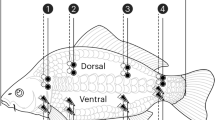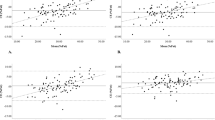Abstract
OBJECTIVE: To validate the assessment of total body water (TBW) and extracellular water (ECW) by multi-frequency bioelectrical impedance. SUBJECTS: Twenty-five overweight but otherwise healthy subjects and 20 lean subjects. DESIGN: Cross-sectional. MEASUREMENTS: TBW and ECW were determined by dilution techniques. Prediction equations from the literature were used to calculate TBW and ECW from measured impedance at 100 and 50 kHz or 1 and 5 kHz, respectively. In 18 of the obese subjects, impedance was also measured with the electrodes placed at proximal sites. RESULTS: In lean and obese subjects, significant correlations were observed between the impedance index (H2/Z) at high frequencies with TBW (r=0.90, P<0.001 in lean and r=0.80, P<0.001 in obese subjects) and at low frequencies with ECW (r=0.87, P<0.001 and r=0.77, P<0.001 respectively). Proximal placement of electrodes slightly im- proved the correlation between the impedance index and TBW (from r=0.83 to r=0.90 at 50 kHz and from r=0.85 to r=0.90 at 100 kHz) and ECW (from r=0.77 to r=0.83 at 1 kHz and from r=0.79 to r=0.85 at 5 kHz). The association of ECW and TBW with H2/Z was different for obese and lean subjects: in obese subjects a given amount of TBW or ECW corresponded with a lower index. An equation consisting only of the impedance index could predict TBW and ECW with small mean errors in lean (1.3 and 0.8 kg respectively) and obese subjects (0.1 and 0.0 kg respectively). Applying a more specific equation, including other subject characteristics, resulted in larger prediction errors in obese subjects, illustrating the population specificity of prediction equations. Furthermore an association was observed of the prediction bias of TBW and ECW with TBW (r=0.48, P<0.01) and ECW (r=0.70, P<0.001) respectively, and with body water distribution (r=−0.38 and r=0.33 respectively, P<0.05). TBW and ECW were also associated with weight (r=0.76 and r=0.71 respectively, P<0.001) and body mass index (BMI) (r=0.54 and r=0.53 respectively, P<0.001). CONCLUSION: It appeared from this study that the accuracy of TBW and ECW estimation with the impedance technique is dependent on the absolute amount of TBW and ECW. A higher amount of TBW and ECW in obese subjects may contribute to a difference in prediction error between lean and obese individuals.
This is a preview of subscription content, access via your institution
Access options
Subscribe to this journal
Receive 12 print issues and online access
$259.00 per year
only $21.58 per issue
Buy this article
- Purchase on Springer Link
- Instant access to full article PDF
Prices may be subject to local taxes which are calculated during checkout
Similar content being viewed by others
Author information
Authors and Affiliations
Rights and permissions
About this article
Cite this article
Steijaert, M., Deurenberg, P., Van Gaal, L. et al. The use of multi-frequency impedance to determine total body water and extracellular water in obese and lean female individuals. Int J Obes 21, 930–934 (1997). https://doi.org/10.1038/sj.ijo.0800497
Issue Date:
DOI: https://doi.org/10.1038/sj.ijo.0800497
Keywords
This article is cited by
-
Repository Describing the Anatomical, Physiological, and Biological Changes in an Obese Population to Inform Physiologically Based Pharmacokinetic Models
Clinical Pharmacokinetics (2022)
-
Validity of multi-frequency bioelectric impedance methods to measure body composition in obese patients: a systematic review
International Journal of Obesity (2019)
-
Monitoring of body water composition by the simultaneous use of bioelectrical impedance analysis and Crit-Line® during hemodialysis
Clinical and Experimental Nephrology (2014)
-
The altered fluid distribution in obesity may reflect plasma hypertonicity
European Journal of Clinical Nutrition (2007)
-
Comparison of Three Bioelectrical Impedance Methods with DXA in Overweight and Obese Men*
Obesity (2006)



